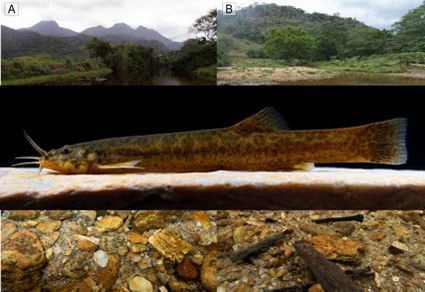Abstract
The coastal river basins of southeastern Brazil located within the limits of the Atlantic Forest harbour a diverse fauna of Trichomycterinae catfishes, with new species being continually described in recent years. Here we describe a new species that was previously misidentified in molecular phylogenies as Trichomycterus caipora Lima, Lazzaroto & Costa, 2008, where it was supported as sister to Trichomycterus nigricans Valenciennes, 1832 from the Rio Macacu basin, belonging to a clade that also includes Trichomycterus santaeritae (Eigenmann, 1918) from the Rio Paraíba do Sul basin. The three species share the presence of nine pectoral-fin rays, a long maxilla that is longer than the premaxilla and a robust opercular patch of odontodes. The new species is diagnosed by a combination of morphological characters involving opercular and jaw dentition, colour pattern, and some morphometric features. It is endemic to the Rio Imbé basin, is the first record of the genus for this basin, and it fills a gap in the knowledge of the geographical distribution of the Trichomycterinae. Interestingly, the new taxon and its sister species, T. nigricans, have divergent ecomorphological characteristics, with the former one having diurnal habits, and the latter one, nocturnal. Both species are known only from low-altitude areas, a unique condition in the subgenus Trichomycterus.
References
- Abilhoa, V., Braga, R.R., Bornatowski, H. & Vitule, J.R.S. (2011) Fishes of the Atlantic Rain Forest streams: ecological patterns and conservation. In: Grillo, O. & Venora, G. (Eds.), Changing Diversity in Changing Environment. InTech, Rijeka, pp. 259–282. https://doi.org/10.5772/24540
- Arratia, G. & Huaquin, L. (1995) Morphology of the lateral line system and of the skin of diplomystid and certain primitive loricarioid catfishes and systematic and ecological considerations. Bonner Zoologische Monographien, 36, 1–110.
- Bockmann, F.A. & Sazima, I. (2004) Trichomycterus maracaya, a new catfish from the upper rio Paraná, southeastern Brazil (Siluriformes: Trichomycteridae), with notes on the T. brasiliensis species-complex. Neotropical Ichthyology, 2, 61–74. https://doi.org/10.1590/S1679-62252004000200003
- Costa, W.J.E.M. (1992) Description de huit nouvelles espèces du genre Trichomycterus (Siluriformes: Trichomycteridae), du Brésil oriental. Revue française d’Aquariologie et Herpetologie, 18, 101–110.
- Costa, W.J.E.M. (2009) Peixes aploqueilóideos da Mata Atlântica brasileira: história, Diversidade e Conservação/Aplocheiloid Fishes of the Brazilian Atlantic Forest: History, Diversity and Conservation. Museu Nacional, Universidade Federal do Rio de Janeiro, Rio de Janeiro, 172 pp.
- Costa, W.J.E.M. (2021) Comparative osteology, phylogeny and classification of the eastern South American catfish genus Trichomycterus (Siluriformes: Trichomycteridae). Taxonomy, 1, 160–191. https://doi.org/10.3390/taxonomy1020013
- Costa, W.J.E.M., Katz, A.M., Mattos, J.L.O., Amorim, P.F., Mesquita, B.O., Vilardo, P.J. & Barbosa, M.A. (2020a) Historical review and redescription of three poorly known species of the catfish genus Trichomycterus from south-eastern Brazil (Siluriformes: Trichomycteridae). Journal of Natural History, 53, 2905–2928. https://doi.org/10.1080/00222933.2020.1752406
- Costa, W.J.E.M., Mattos, J.L.O., Amorim, P.F., Vilardo, P.J. & Katz, A.M. (2020b) Relationships of a new species support multiple origin of melanism in Trichomycterus from the Atlantic Forest of south-eastern Brazil (Siluriformes: Trichomycteridae). Zoologischer Anzeiger, 288, 74–83. https://doi.org/10.1016/j.jcz.2020.07.004
- Costa, W.J.E.M., Mattos, J.L., Vilardo, P.J., Amorim, P.F. & Katz, A.M. (2022) Perils of Underestimating Species Diversity: Revisiting Systematics of Psammocambeva Catfishes (Siluriformes: Trichomycteridae) from the Rio Paraíba do Sul Basin, South-Eastern Brazil. Taxonomy, 2, 491–523. https://doi.org/10.3390/taxonomy2040032
- Eigenmann, C.H. (1918) The Pygidiidae, a family of South American catfishes. Memoirs of the Carnegie Museum, 7, 259–398. https://doi.org/10.5962/p.34486
- Katz, A.M., Barbosa, M.A., Mattos, J.L.O. & Costa, W.J.E.M. (2018) Multigene analysis of the catfish genus Trichomycterus and description of a new South American trichomycterine genus (Siluriformes, Trichomycteridae). Zoosystematics and Evolution, 94, 557–566. https://doi.org/10.3897/zse.94.29872
- Kubicek, K.M. (2022) Developmental osteology of Ictalurus punctatus and Noturus gyrinus (Siluriformes: Ictaluridae) with a discussion of siluriform bone homologies. Vertebrate Zoology, 72, 661–727. https://doi.org/10.3897/vz.72.e85144
- Lima, S.M.Q., Lazzarotto, H. & Costa, W.J.E.M. (2008) A new species of Trichomycterus (Siluriformes: Trichomycteridae) from lagoa Feia drainage, southeastern Brazil. Neotropical Ichthyology, 6 (3), 315–322. https://doi.org/10.1590/S1679-62252008000300004
- Menezes, N.A., Weitzman, S.H., Oyakawa, O.T., Lima, F.C.T., Castro, R.M.C. & Weitzman, M.J. (2007) Peixes de Água Doce da Mata Atlântica, Lista Preliminar das Espécies e Comentários Sobre Conservação de Peixes de Água Doce Neotropicais / Freshwater Fishes of Mata Atlântica, Preliminar List of Species and Comments on Conservation of Neotropical Freshwater Fishes. Museu de Zoologia, Universidade de São Paulo, São Paulo, 407 pp.
- Myers, N., Mittermeir, R.A., Mittermeir, C.G., da Fonseca, G.A.B. & Kent, J. (2000) Biodiversity hotspots for conservation priorities. Nature, 403, 853–858. https://doi.org/10.1038/35002501
- Taylor, W.R. & Van Dyke, G.C. (1985) Revised procedures for staining and clearing small fishes and other vertebrates for bone and cartilage study. Cybium, 9, 107–119.
- Weitzman, S.H., Menezes, N.A. & Weitzman, M.J. (1988) Phylogenetic biogeography of the Glandulocaudini (Teleostei: Characiformes, Characidae) with comments on the distributions of other freshwater fishes in eastern and southeastern Brazil. In: Vanzolini, P.E. & Heyer, W.R. (Eds.), Proceedings of a Workshop on Neotropical Distribution Patterns. Academia Brasileira de Ciências, Rio de Janeiro, pp. 379–427.
- Vilardo, P.J., Katz, A.M. & Costa, W.J.E.M. (2023) Phylogeny and historical biogeography of neotropical catfishes Trichomycterus (Siluriformes: Trichomycteridae) from eastern Brazil. Molecular Phylogenetics and Evolution, 186, 107836. https://doi.org/10.1016/j.ympev.2023.107836


